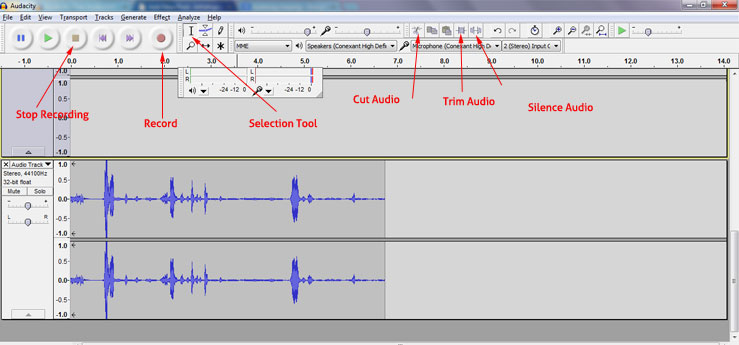

- #USE AUDACITY LIKE AUDIO HIJACK PRO FULL#
- #USE AUDACITY LIKE AUDIO HIJACK PRO PRO#
- #USE AUDACITY LIKE AUDIO HIJACK PRO MAC#
In general the operator may (1) elect to work with the compressed/attenuated audio, or (2) apply makeup gain to compensate for the resulting attenuation. A Downward Expander applies a much more gradual transition between audibility and attenuation.Ī traditional compressor applies gain reduction (dynamic range compression) when signal levels exceeds a defined threshold. Note the general difference between a Gate and Downward Expander: a Gate applies a sort of hard mute. When the passing signal level drops below the defined Threshold fader setting – attenuation is initialized. The included Gate is essentially a Downward Expander. The Energy Meter’s internal chain placement is located after the Leveler processing and before the plugin’s remaining dynamics modules. Basically, automatic gain-riding initializes when the passing signal level exceeds the threshold and correlated target. The inherent processing uses long attack and release times similar in attributes to an RMS compressor to effectively maintain consistent levels over time. The Leveler fader value defines the AGC threshold and target. Let’s explore the attributes of MaxxVolume … The plugin features High/Low Level Compressor modules, a Downward Expander, a Leveler stage (aka RMS compressor/AGC), a user selectable Loud/Soft ARC flag, and a global Output Gain control. MaxxVolume is a multi-stage dynamics processor. I believe the original selling price was $400.

I paid $149 for the plugin, on sale at the time over at DontCrack. Categories Audio Post Production, Audio Recording and Production, Podcasting Tags Podcast Production Leave a commentĪn obscure and rarely mentioned audio plugin by Waves exists that is well suited for Spoken Word processing, Live Streaming, and Podcast Post Production – MaxxVolume.īack in 2012 I documented my initial interest and subsequent purchase of MaxxVolume. Note it is certainly fine to check and/or monitor a MIX through (various types of) near field monitors *after* all of the above variables have been addressed.Īnd don’t forget to maintain awareness of typical consumption methods and devices, such as laptop speakers, trendy headphones, smart phones, earbuds, and vehicles. They are absolutely vital for this type of audio post throughout various stages of your workflow. Closed back headphones OTOH are paramount. In my view the sole use of near field monitors for Podcast post production is not your best option. (G) Replicate typical consumption methods and environments (E) Recognize and eliminate subtle mouth noises (D) Execute intricate/seamless dialogue edits (A) Establish audible awareness of (low-level) noise floor nuances Without proper isolation – it would be difficult to: That said, there’s some chatter out there referring to producing and mixing Podcasts solely through fancy near field monitors.Ĭonsider this: what about efficiently dealing with inherent audio clip attributes that require isolation as well as the subjective processing tasks/optimizations typically applied at the pre-mixing stage? The vast majority of producers, engineers, and/or “editors” working with typical spoken word Podcast audio are not using calibrated reference monitors in quiet work spaces with optimized acoustics.
#USE AUDACITY LIKE AUDIO HIJACK PRO PRO#
Categories Audio Post Production, Audio Recording and Production Tags Pro Tools Leave a comment Note Aux I/O is not available in “Pro Tools Intro.”
#USE AUDACITY LIKE AUDIO HIJACK PRO FULL#
I concluded a full system restart is necessary in order to instantiate customized configurations. It appears Avid is providing support to add up to 16 lines/devices in the configuration file.
#USE AUDACITY LIKE AUDIO HIJACK PRO MAC#
It’s reference will be updated in Mac System Preferences/Sound options for possible system wide use as well. Results: Channel configuration is now 1×1 (discrete MONO) with a customized Device Name: PT MONO VD. That’s a 2 channel device (2/2 discrete) followed by the name of the Audio Bridge. In the displayed image the listed Audio Bridge in line 4 read by default: Path: Macintosh HD/Library/Audio/Plug-Ins/HAL/ProToolsAudioBridge.driver/Contents/Resources

** To customize a Pro Tools Audio Bridge Device Name and channel configuration:Īccess and edit the nfig text file: Do this by simply activating an editable text field. Users can edit associated Display Name references representing the instance of any listed Device. In essence you cannot customize the noted attributes.

channel configuration) are fixed in this window. You will notice Pro Tools supplied Audio Bridges are listed in the Device Name column. Press Aux I/O button under Input or Output tabs. To access the Aux I/O configuration window: … I/O.


 0 kommentar(er)
0 kommentar(er)
